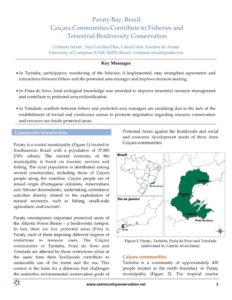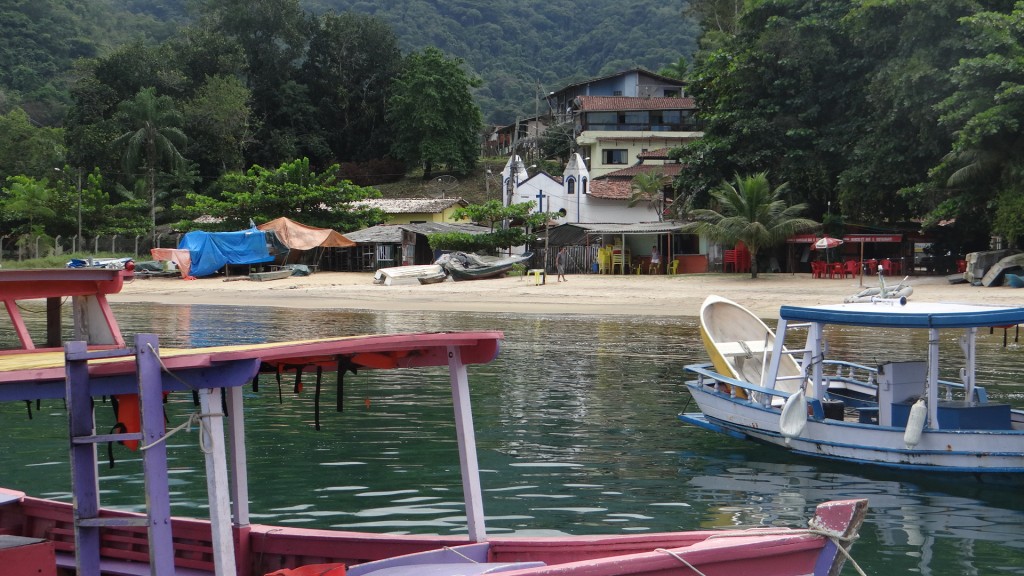
15 Dec Paraty Bay, Brazil
Cristiana Seixas1, Ana Carolina Dias, Camila Islas, Luciana de Araujo.
University of Campinas (UNICAMP), Brazil; 1cristiana.seixas@gmail.com
Key Messages
• In Tarituba, participatory monitoring of the fisheries, if implemented, may strengthen agreements and interactions between fishers and the protected area manager and improve decision-making.
• In Praia do Sono, local ecological knowledge was recorded to improve terrestrial resource management and contribute to protected area reclassification.
• In Trindade, conflicts between fishers and protected area managers are escalating due to the lack of the establishment of formal and continuous arenas to promote negotiation regarding resource conservation and resource use inside protected areas.
Community Introduction
Paraty is a coastal municipality (Figure 1) located in Southeastern Brazil with a population of 37,000 (74% urban). The current economy of the municipality is based on tourism, services and fishing. The rural population is distributed among several communities, including those of Caiçara people along the coastline. Caiçara people are of mixed origin (Portuguese colonists, Amerindians and African descendants), undertaking subsistence activities directly related to the exploitation of natural resources, such as fishing, small-scale agriculture, and tourism1.
Paraty encompasses important preserved areas of the Atlantic Forest Biome – a biodiversity hotspot. In fact, there are five protected areas (PAs) in Paraty, each of them imposing different degrees of restrictions to resource users. The Caiçara communities of Tarituba, Praia do Sono and Trindade are affected by those restrictions while at the same time their livelihoods contribute to sustainable use of the forest and the sea. This context is the basis for a dilemma that challenges the restrictive environmental conservation goals of Protected Areas against the livelihoods and social and economic development needs of these three Caiçara communities.
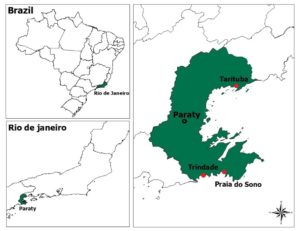
Figure 1: Paraty, Tarituba, Praia do Sono and Trindade (elaborated by Camila Alvez Islas).
Caiçara communities
Tarituba is a community of approximately 430 people located at the north boundary of Paraty municipality (Figure 2). The tropical marine ecosystem adjacent to Tarituba has experienced several changes over the last half century including declining fish stocks, invasion of exotic species, increased water pollution due to land development as well as the development of an offshore oil and gas industry2,3. Community livelihood activities are based on local resources (mainly fish), tourism, and the private sector. Tarituba fisheries take place inside the Ilha Grande Bay.
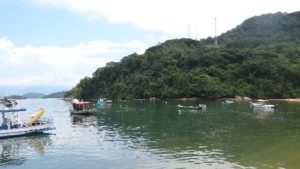
Figure 2: Tarituba – Ana Carolina Diaz
Praia do Sono is located on the southern coast of Paraty municipality, 25 km from the downtown area. The community (Figure 3) of 320 inhabitants is only accessed by boat or on foot (1 hour walking trail from the nearest road access). Fishing, tourism-related activities, and small-scale agriculture account for most of the local livelihoods1,4.
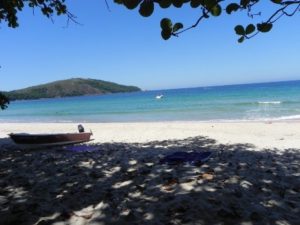
Figure 3: Praia do Sono Community – Camila Islas
Trindade has about 1,000 inhabitants, of which about 50 are small-scale fishers1,5. The community area overlaps with two Protected Areas – Serra da Bocaina National Park (SBNP) and Cairuçu Environmental Protected Area. Tourism and fisheries are important components of local livelihood1 (Figure 4).
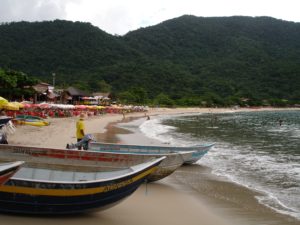
Figure 4: Trindade Community – Luciana Araujo
Conservation and Livelihood Challenges
In Tarituba, the main fishing spots are inside Tamoios Ecological Station, which is a no-take Protected Area (PA). Tamoios Ecological Station was established in 1990 as a compensatory measure for the nuclear power plant of Angra dos Reis, but was only implemented in 2008. The PA has generated serious conflicts between fishers and the PA managers, because Tamoios Ecological Station was created in a top-down manner, restricting local livelihoods2,3.
Praia do Sono is located inside the Juatinga Ecological Reserve (REJ), created in 1992 to protect the Atlantic Forest and Caiçara communities living inside this area. The “Ecological Reserve” is not a category currently recognized within Brazil’s National System of Protected Areas established by law in 2000 (SNUC), hence REJ is currently under a reclassification process. This reclassification will affect Praia do Sono, as it will either fall under a more restrictive management system or lead to an arrangement that allows for sustainable resource use. The Atlantic Forest is an important source of resources; many community members possess valuable local ecological knowledge about its wildlife. The Atlantic Forest’s potential in provisioning aesthetic or tourism services, as well as the use of non-timber forest products, makes it vulnerable to change.
In 2010, a participatory assessment of the sustainability of Trindade fisheries was conducted by a local NGO to support a fisheries agreement between the Serra da Bocaina National Park and small-scale fishers in the scope of the Bocaina Mosaic Council6 (council which oversees conservation efforts). The head of the park did not legitimate this initiative because fisheries in Trindade were not a priority in the park’s management agenda. Eventually, the final report of the Trindade fisheries assessment was not acknowledged by the head of the park and the council of the Mosaic did not take action resulting from the assessment. The lack of acknowledgement of the Trindade fisheries in the final report has generated uncertainty among fishers, a lack of confidence in the Mosaic’s council, and intensified conflict between fishers and the park6,7.
In the consultative Council of the park, one of the priorities of the current officers is tourism within the protected area, in a partnership with a community-based organization that is led by local tourism boat-owners and fishers. However, the communication between community leaders and managers during the meetings is unidirectional and controlled by the PA managers. Community members do not understand the rules governing the PAs and attribute this difficulty to the lack of access to information and little dialogue with managers. Since 2010, fishers and community leaders from Trindade are seeking to build arenas to discuss problems related to the restrictions of the park over the land and marine areas of the PA, with the Park head. These initiatives include their participation in (i) the review of the Management Plan of the Park, (ii) building agreements related to tourism activities done inside the marine area of the Park, and (iii) the negotiation to build an agreement to control fisheries inside the marine portion of the Park5,6,7.
Community Initiative
Efforts are underway, in all three communities, to ensure community rights to access resources within protected areas (PAs) and contribute to community conservation of both fisheries and terrestrial resources. These efforts are supported by local and university partners, the latter being UNICAMP (Brazil) and the University of Manitoba (Canada).
In Tarituba, an agreement has been developed between fishers and Tamoios Ecological Station in order to allow certain fishing gear and vessels inside the PA. The fishers are concerned about fisheries management, conservation, and their own livelihoods. Agreeing to meet, both fishers and PA managers attended workshops to express concerns and demands while learning about the others’ concerns and agenda. Joint discussion on local livelihoods and conservation led to the designing of a Terms of Agreement in 2013, however, this agreement has not been officially issued yet due to internal conflicting agendas within the PA government agency.
In Praia do Sono, the local community is working with researchers to improve terrestrial resources management, and to contribute to the debate on PA reclassification. Locals and PA staff participated in interviews and wildlife photo identification.
In Trindade, examining the institutional context of fisheries and PAs is essential in order to analyze how the community interacts within institutional contexts and to determine how this influences small-scale fisheries on a local level. Ongoing research in Trindade is analyzing (a) what communities and PA managers have been learning over the past 8 years when PAs started to be implemented in the communities and (b) how implementation impacts fisheries on a local level. Workshops about participatory monitoring were developed with the community, to discuss building a monitoring process for fisheries and tourism, based on local knowledge and developed by the community. The next step is the development of a monitoring protocol with some fishers of Trindade.
Practical Outcomes
Tarituba
As a result of the increasing interactions between PA managers and fishers, a better dialogue system and a better understanding of needs and beliefs has been established between fishers and PA managers, leading to the design of the participatory monitoring program of artisanal fisheries3. Although both fishers and, to a lesser extent, PA managers are unsure of who is ultimately responsible for conservation, the participatory monitoring program will be important in reducing conflict and in improving decision-making among protected area management and ensuring local fisheries rights, food security and traditional livelihoods. In parallel, further research in Tarituba will attempt to better understand the institutional arrangements and degrees of restrictions of PAs, its influence on community based conservation, and how this is reflected within fisher stewardship.
Praia do Sono
Community members express how local ecological knowledge is being lost due to increased contact with regional markets and, over the last decade, due to new religion restrictions; however, the norms and practices regarding stewardship and conservation that were initially created from the local ecological knowledge of community members are still playing a role in natural resources management. Although hunting has impacts on wildlife, and has been criminalized, local rules and taboos may help promote sustainable use and resource conservation4. Incorporating local ecological knowledge in PA management may offer a faster assessment of wildlife than conventional biological research as well as local management rules for sustainable wildlife use within PAs. Empowerment of the local community is essential so that they can better negotiate their rights to access resources and practice their traditional livelihoods with the no-take protected area manager.
The research regarding local knowledge on wildlife and its management has triggered considerable discussion among locals and the PA staff. A Praia do Sono leader has highlighted the importance of communities working together with the university to negotiate with government over the rights of traditional communities to their land.
Trindade
Community members have been expressing frustration on how the implementation of PAs has influenced their livelihood. Since 2010, when the Consultative Council of the Park was created, not much has advanced in terms of participatory management, shared decision-making and integration between conservation goals and livelihoods. Nevertheless, community leaders continue to participate in different arenas to claim their rights over their land and sea, seeking to develop agreements with the park regarding tourism and fishing.
With advice from researchers, fishers are debating developing a monitoring protocol for fisheries and tourism. Although two workshops have been conducted about this topic, the monitoring plan was not developed yet because fishers are involved in other activities. They have been investing their time engaging in a national network that represents small-scale fishers throughout the country to get better opportunities to negotiate their demands.
Paraty
For Paraty Bay as a whole, insights from seven years of partnerships among communities, fishers and university researchers have been compiled. A series of upcoming workshops involving fishers and community members from Tarituba, Trindade and Praia do Sono will discuss these insights as well as advances and barriers to community conservation and commons governance. The three communities will also host further workshops about learning processes involving governance in coastal communities and protected areas.
References
1. Hanazaki, N., Berkes, F., Seixas, C. S., & Peroni, N. 2013. Livelihood Diversity, Food Security and Resilience among the Caiçara of Coastal Brazil. Human Ecology, 41 (1):153-164.
2. De Freitas, R. R. 2014. Implicações de políticas de conservação e desenvolvimento na pesca artesanal costeira em uma área marinha protegida da Baía da Ilha Grande. PhD Thesis. State University of Campinas. 273p.
3. Dias, A.C.E. 2015. Fisheries participatory monitoring at Tarituba community, Paraty (Brazil): Reconciling conservation and small-scale fisheries. Masters Thesis, State University of Campinas, Brazil. 188p.
4. Islas, C.A. 2015. Conhecimento Ecológico Tradicional Caiçara sobre animais silvestres como aporte para um Manejo de Base Ecossistêmica. Masters Thesis, State University of Campinas, Brazil. 199p.
5. Bockstael E, Bahia NCF, Seixas CS, Berkes F. 2016. Participation in protected area management planning in coastal Brazil. Environmental Science & Policy 60: 1–10
6. Araujo, L. 2014. A Pesca Costeira Artesanal de Paraty, RJ: Uma Análise Multiescalar sob o Enfoque da Cogestão de Recursos Comuns. Doctoral dissertation. IFCH/NEPAM/UNICAMP. Universidade Estadual de Campinas. 362p.
7. Bahia, N.C., Seixas, C.S., Araujo, L.G., Farinaci, J.S. & Chamy, P. 2013. Implementation of a national park over traditional lands of the Trindade community in Paraty, Brazil In: Magro, T. C.; Rodrigues, L. M.; Silva Filho, D. F. ; Polizel, J. L.; Leahy, J.; (Eds.). Protected Areas and Place Making: How do we provide conservation, landscape management, tourism, human health and regional development? Protected Areas and Place Making Conference Proceedings. Piracicaba: ESALQ. 46-51pp.



